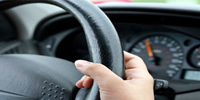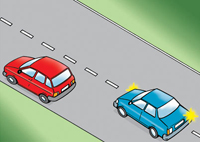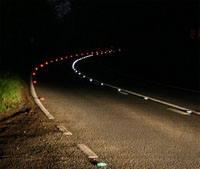Road Safety Tips
Driving Along
Be alert to the traffic around you as you drive. Make a routine of looking behind and from side by checking your mirrors every few seconds. Check your blind spots by turning your head to look over your shoulder. Try to keep other vehicles out of your blind spot by changing your speed and try not to drive in other vehicles' blind spots. Be extra alert at dawn and dusk when drivers have problem adjusting to the changing light.
Steer Smoothly
 Steer smooth and precise. Do most steering and lane changes having both hands on the steering wheel. You should try to steer in a straight line while shifting gears, adjusting controls or checking your blind spot.
Steer smooth and precise. Do most steering and lane changes having both hands on the steering wheel. You should try to steer in a straight line while shifting gears, adjusting controls or checking your blind spot.
Keep Left
Keep to the left of the road or in the left-hand lane on multi-lane roads unless you want to turn right or want to overtake another vehicle.
Roundabout
If you are about to enter the round-about, give way to traffic on your right. The rule applies to those cars also that have to turn left after entering the round-about.
Controlled Intersection with Traffic Signals
Driver turning left using a slip lane must give way to any vehicles on the road. He should give way to a vehicle that is coming straight or turning right into the road the driver is about to enter.
Controlled Intersection (Stop or Give Way Sign)
The driver must stop at the stop line. If there is no stop line, the driver must stop before entering the intersection and must give way to a vehicle in the intersection.
Uncontrolled Intersection (No Sign/Signal)
A driver at an intersection (except a T-intersection or roundabout) without traffic lights or a stop sign, stop line, give way sign or give way line, must give way in accordance with this rule.
If the driver is going straight ahead, the driver must give way to any vehicle approaching from the right, unless a stop sign, stop line, give way sign or give way line applies to the driver of the approaching vehicle.
If the driver is turning left, the driver must give way to any vehicle approaching from the right, unless a stop sign, stop line, give way sign or give way line applies to the driver of the approaching vehicle any pedestrian at or near the intersection on the road the driver is entering.
If two vehicles are facing green lights the driver who has to turn right should give way to the vehicle approaching from the opposite direction and going straight.
Changing lanes
You might need to change lanes on roads with more than one lane in the same direction. You may want to change lanes to overtake another vehicle, to avoid a parked vehicle or when the vehicle ahead slows to turn at an intersection. Always give proper signal before changing lanes and ensure the move can be made safely.
Steps for changing lanes
- Check for a space in traffic where you can enter safely.
- Check your blind spot by looking over your shoulder in the direction of the lane change. Give an indicator in the direction you want to move.
- Recheck to ensure the way is clear and that no one is coming at a fast speed from behind.
- Turn steadily into the new lane.
Do not change lane suddenly by cutting in front of another vehicles. The other drivers will not be expecting your maneuver.
Avoid changes lanes unless required. Don't change lanes in or near an intersection.
Spending a few seconds behind another vehicle is often safer than going around it.
Overtaking
 Overtaking is changing lanes to move past a slower vehicle. Never overtake other vehicle unless you are absolutely sure you can do so without danger to yourself or others.
Overtaking is changing lanes to move past a slower vehicle. Never overtake other vehicle unless you are absolutely sure you can do so without danger to yourself or others.
Points to consider while overtaking a vehicle
- Use your right-turn indicator to show that you want to overtake. Check the way ahead and behind is clear before overtaking.
- Watch out for scooters or motor cycles that may be hidden from view in front of the vehicle you are about to overtake. Watch for vehicles that may be turning right in front of you.
- After overtaking, give indicator that you want to get back into the lane you started from. Change lane when you can see all the front of the vehicle you are passing in your rear view mirror. Never cut off a vehicle by suddenly moving in front of it.
- Do not race if the vehicle you are passing speeds up. Get back into your original lane.
Do not overtake within 30 metres of a pedestrian crossing. When another vehicle wants to overtake you, move to the left and let it pass. Be prepared to slow down to allow the overtaking vehicle get into your lane ahead of you. The other driver may not have anticipated the speed of the oncoming vehicle.
Tips for Driving During Night
 Driving at night is the most dangerous time to drive, no matter what weather condition is present. The most dangerous time to drive on any roadway is between the hours of midnight and 6am, especially on the weekends. Luckily, there are some things you can do to improve your safety when driving at night.
Driving at night is the most dangerous time to drive, no matter what weather condition is present. The most dangerous time to drive on any roadway is between the hours of midnight and 6am, especially on the weekends. Luckily, there are some things you can do to improve your safety when driving at night.
Don't overdrive your headlights
Most speed limits are set for driving during the day in dry, clear conditions. Not for driving at night. Your headlights should illuminate the road ahead of you for approximately 4 seconds headway. If you have poor headlights or you aren't getting at least a 4 second headway, it's best to slow down.
Whenever possible, use your high beam headlights
When driving at night, make sure you utilize your high beam headlights (brights). High beams should be used as often as possible, especially during clear conditions. During adverse weather, use your best judgment. However, don't forget they are on! Be sure to dim your lights for oncoming traffic. The last thing you want to do is blind an oncoming driver, increasing the risk of a head-on collision. If an oncoming vehicle fails to dim their high beams, it's ok to flash your lights to try and remind them, but don't leave your high beams on in spite or to "get back" at the oncoming driver. Again, blinding the driver only increases the chance of a traffic accident. Don't forget to dim your lights for cross traffic and when you come up behind somebody as well!
Look away from the lights!
You should always use proper defensive driving techniques, including keeping your eyes moving, but make sure you don't stare directly at oncoming headlights. If you can safely do so, look towards the right shoulder as the vehicle approaches. Staring at the headlights will impair your night vision, even after the vehicle has passed. Just don't fixate on anything and keep looking ahead while driving.
Driving in Rain!
a) Check the working of wipers, windscreen washing fluid system, all vehicle lights, tyres, exhaust pipe.
b) Be careful and reduce your speed as people may run across the roads in panic.
c) Be considerate to other road users, avoid splashing of water.
d) On slippery roads drive carefully and slowly. In case the vehicle slips, stop acceleration and press the clutch, hold the steering in a straight position and do not brake. Wait till you regain the grip.


